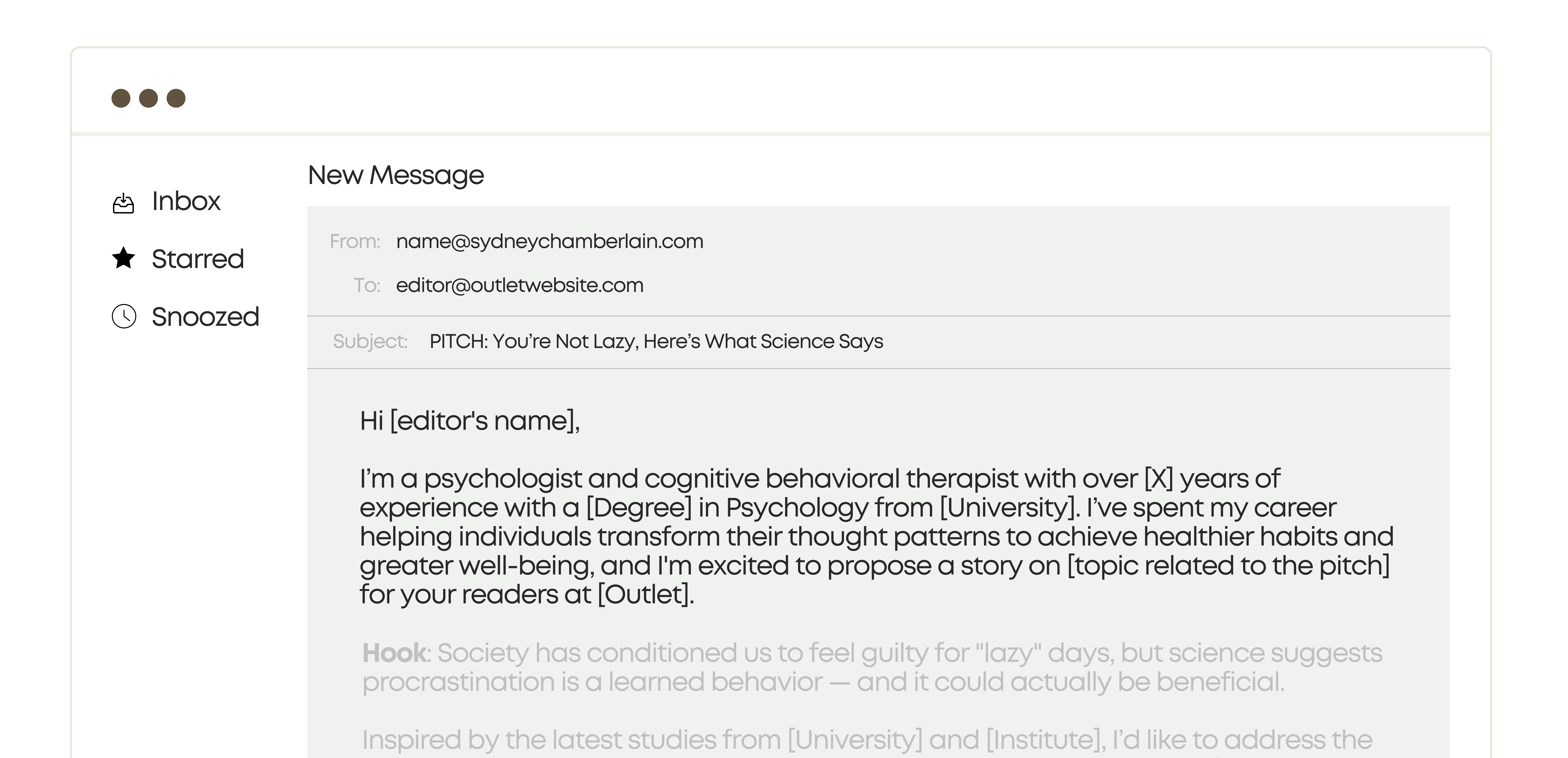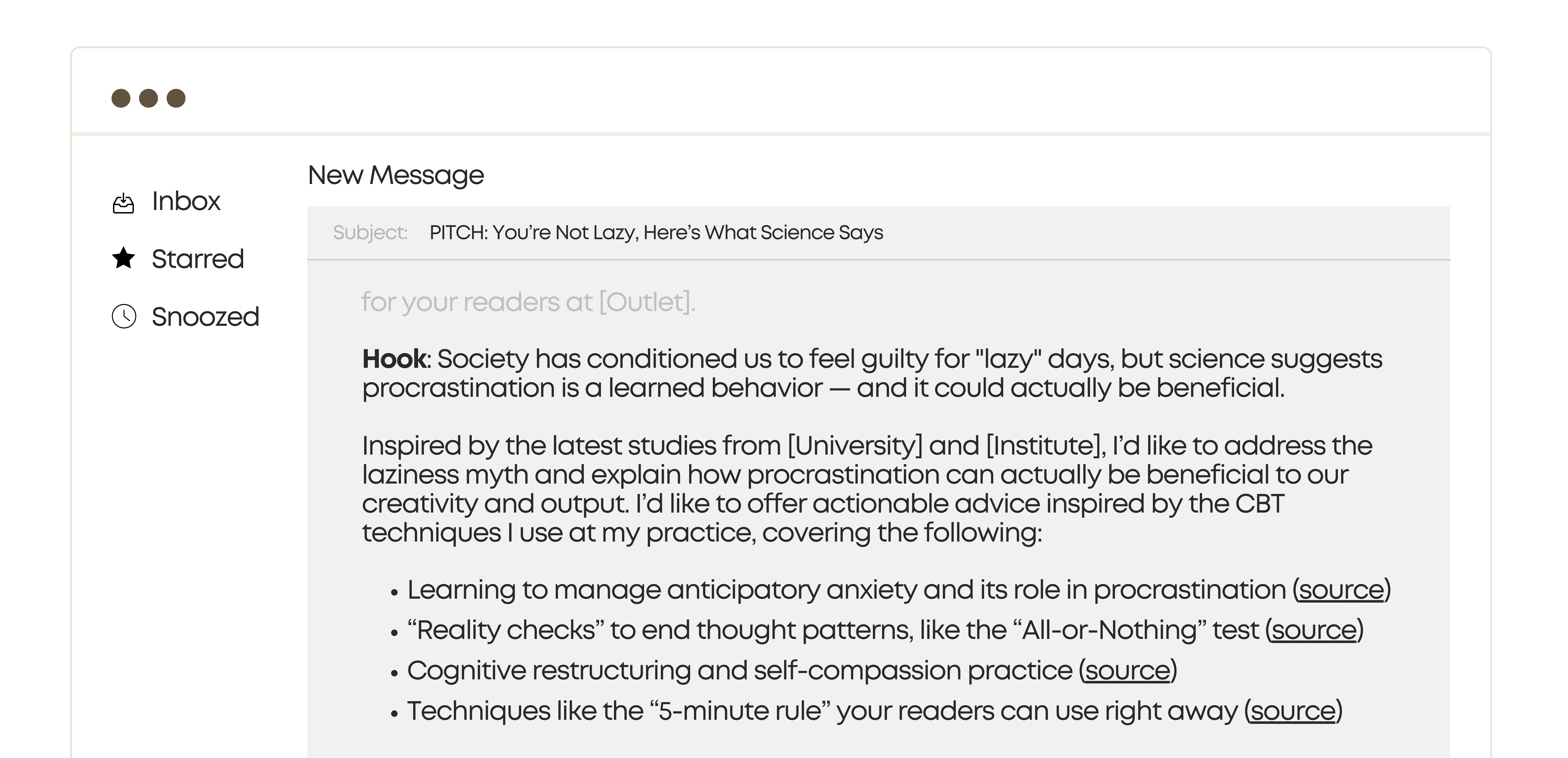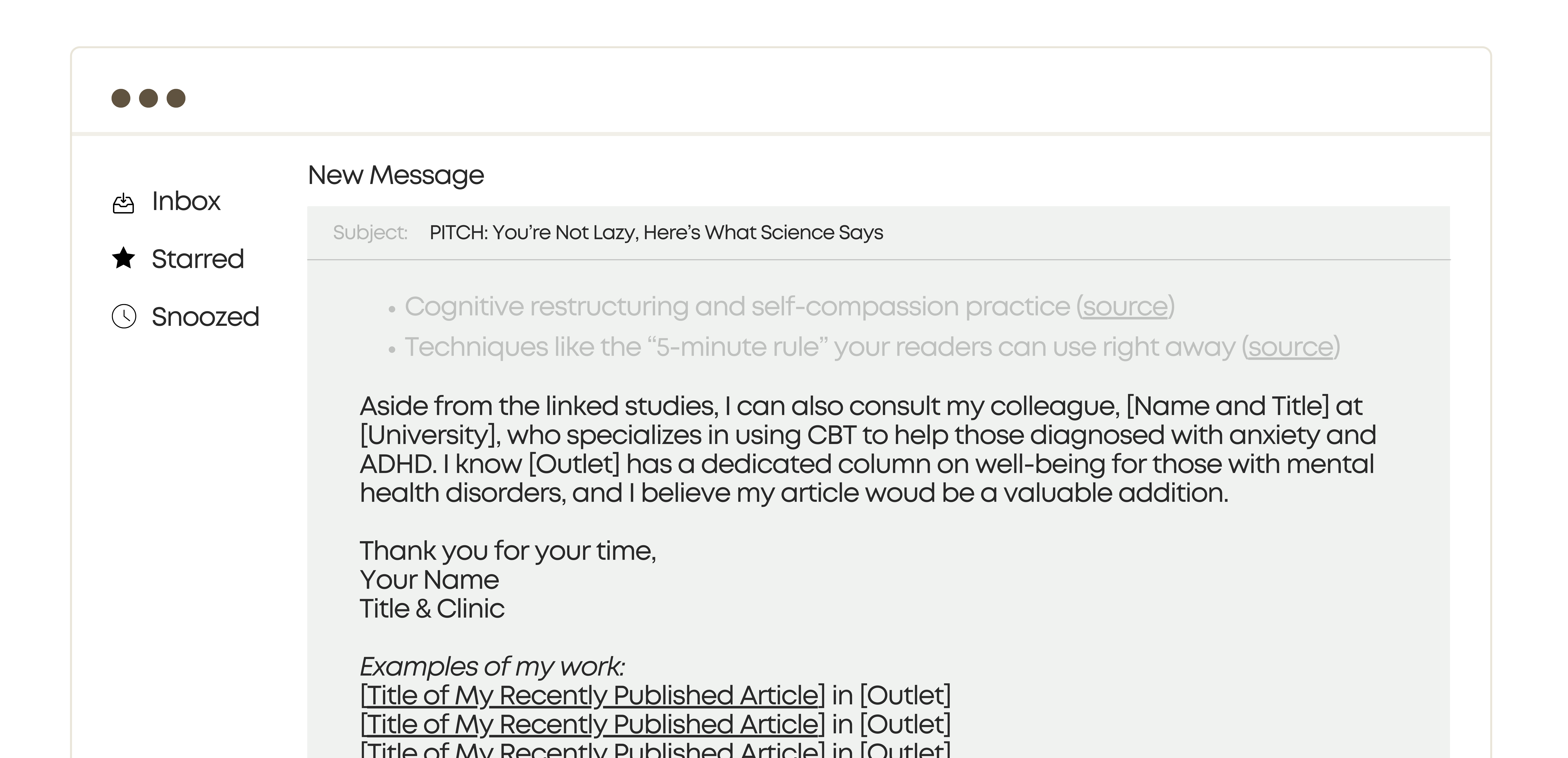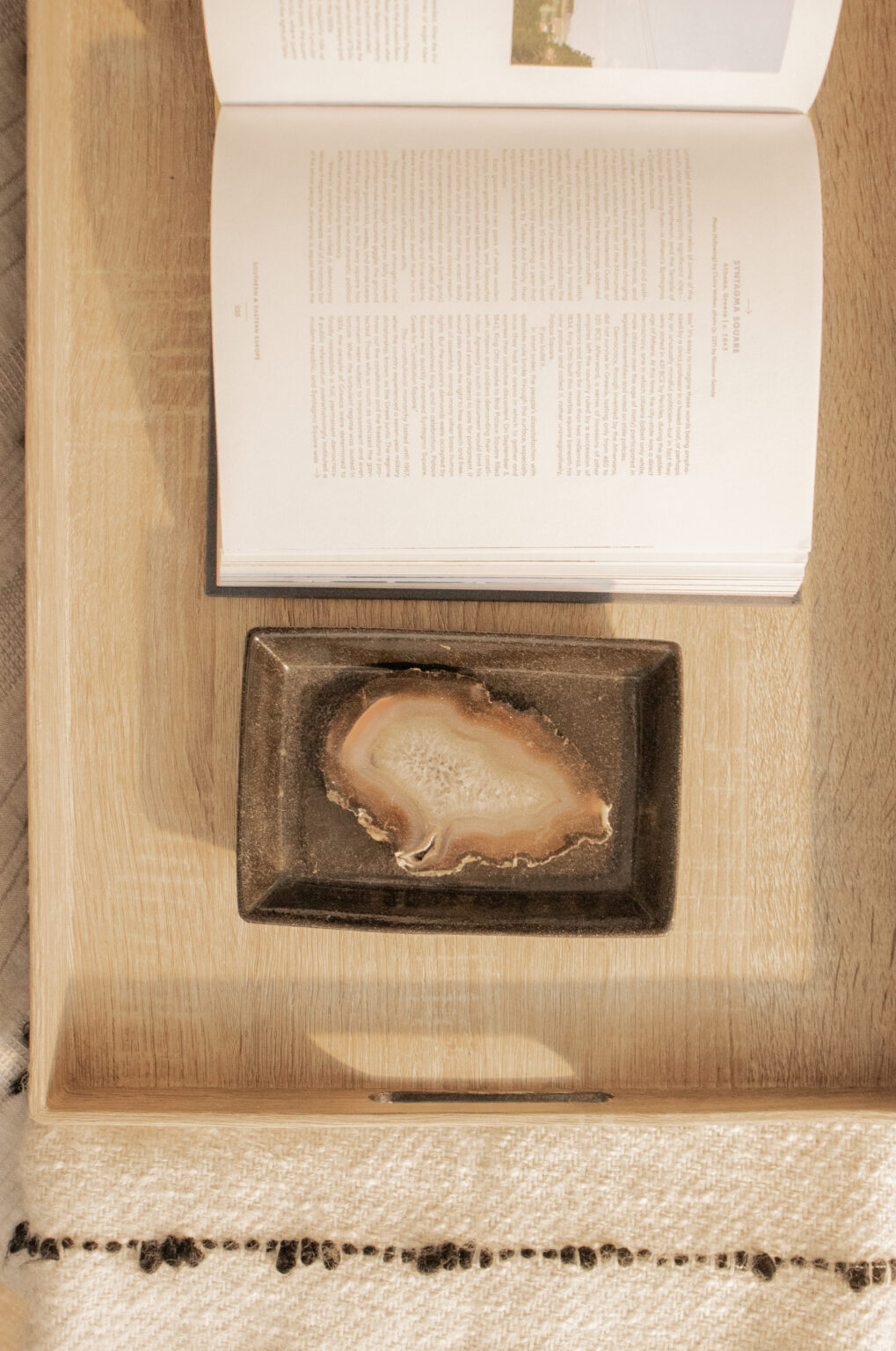A thoughtful, well-written pitch can open doors to opportunities you’ve only dreamed about. It’s a fantastic way to build your network and earn meaningful exposure for yourself — and it doesn’t cost a dime.
If you pitch with confidence, you can get featured in places like Business Insider, Forbes, Good Morning America, and all the niche industry outlets you admire. But, there are some unwritten rules you’ll need to follow to achieve success.
Here’s how make sure your pitches are professional, intriguing, and timely.
What is a media pitch?
A media pitch is a brief, compelling message — usually an email — sent to a journalist, editor, or media outlet that suggests a story you’d like them to cover. The story idea you’re pitching should be relevant, newsworthy, and contribute to your reputation as a credible thought leader in your industry.
You can pitch yourself to:
- Write a story for a magazine or digital outlet, like Vogue or Us Weekly.
- Get quoted as an expert source in an upcoming segment or news story.
- Appear on a podcast, radio station, or TV show.
- Speak at an industry conference or event.
You can also pitch a book idea to a publishing house or a business idea to an investor, but those are very different types of pitches. In this guide, we’re focusing explicitly on media pitches that will earn you exposure.
Why is nailing a pitch so important?
Taking the time to perfect your pitches isn’t necessarily about getting a “yes” today. While it’d be fantastic for every pitch you send to get accepted, setting that expectation will only frustrate you.
Think of each pitch as an introduction to an important new connection. Even if your first few pitches to an outlet don’t get accepted, if you consistently show up with polished, relevant, and interesting ideas, they’ll begin to recognize you and your expertise.
Whatever you do, don’t treat pitching as a numbers game and think that, if you just pump out enough, someone will eventually bite. Every pitch should showcase your communication skills, depth of expertise, and professionalism.
The Anatomy of a Winning Pitch
Some outlets have specific pitching requirements so check the editorial guidelines, but here are the standard elements you’ll need to include:
Subject Line: Come up with a concise and descriptive subject line. It can be as simple as using the working title for your idea. Make sure to start your subject line with “PITCH:” so it gets sorted appropriately.
Personalized Greeting: Address the journalist by name. Very briefly, introduce yourself in a way that demonstrates you’re familiar with the outlet’s audience and why you’re an excellent person to cover your idea.
Share Your Hook: This is the bold statement, question, or compelling statistic your idea is built around that will grab their audience’s attention. Your hook may evolve as you work on the project, but it’s a good practice to share a potential hook in your pitch.
Explain Your Idea: In one paragraph or less, introduce your idea and highlight why it’s relevant, timely, and valuable for the outlet’s audience. Focus on the “so what?” factor. What makes your pitch irresistible?
Supporting Details: Include brief but impactful details that add credibility to your pitch. I usually format this as a short bullet list. This can be statistics (link to sources), anecdotes, quotes, or experts you intend to consult.
Signature: Thank them for their time and make it easy for them to respond by including your full name, title, company (if applicable), and contact information. If you have relevant links (like your website or other features), include them here.
How to Make a Great Pitch
#1 Think Through Your Ideas
Alignment is key when it comes to pitching a successful story. Make sure your idea fits all of the following:
Your business goals — Your idea should bolster your work and area of expertise; it should heavily overlap with the questions or curiosities of your ideal customer; and it should cover topics for which you want to become a go-to expert on and cover again in the future.
The outlet’s style and audience — Every outlet has a unique voice and approach that its audience has come to love, whether it’s practical, strategic, edgy, data-driven, relatable… Your story and angle should match that energy.
The season/timing — Not all themes are bound to a certain time of year (à la health topics) but outlets often prioritize them based loosely on weather, sports, and major events. Familiarize yourself with the media cycle and consider creating an editorial calendar to stay ahead of it.
You’re sure to come up with a lot of great ideas, but you won’t always know who to pitch them to or what angle you want to take. Write them down anyway; as you expand your experience and network, the right opportunity might present itself.
#2 Find The Right Contact
Journalists and editors are generally assigned to specific beats, like business, health, or lifestyle. You’ll need to do some sleuthing to figure out which person is responsible for the section or category that best fits your idea.
Once you have a name, see if they have a dedicated page on the outlet’s website or look in the footer for a “editorial” or “masthead” page. If you can’t find their contact info, check social media. Many editors include their work email in their Twitter/X bio. You can also try messaging them on LinkedIn or Qwoted.
As a general rule, don’t pitch the editor-in-chief; they are already inundated with emails from people who lack attention to detail. However, if you’ve done an exhaustive search, you might try asking them to connect you with the right editor — though I’d try reaching out to a managing editor or executive editor first, especially at a large publication.
#3 Get The Details Right

Even though it’s often only 2-3 paragraphs long, crafting a pitch can take upwards of an hour. Don’t rush this process; remember every pitch is an opportunity to make a valuable new connection.
You don’t need to be sensationalist or clever, but do present your idea in a clear and intriguing way. Emphasize that you’re qualified, enthusiastic, and capable of effectively communicating. And, without losing your own personality, adopt a tone that matches the outlet’s energy.
There’s no rigid format you have to follow, but I generally structure a pitch as follows: A brief greeting, introduction paragraph, proposed hook, paragraph explaining my idea, a bulleted list with sources, and a sign-off.
#4 Support Your Idea
I always recommend sharing a potential “hook,” which is 1-2 sentences that pull the audience in by relating to their needs/emotions and present an interesting promise or question that your piece will cover. Below that, give an overview of what inspired your idea and share your vision.
Most outlets will also expect you to backup your story with sources, but this can look different depending on what you’re pitching or who you are (recognizable names often get a pass on this expectation).

For a personal essay or opinion piece, you might not be asked to find any third-party sources. Instead, you’d want to emphasize how your personal experience and anecdotes make your idea interesting and relatable.
If you’re not sure what’s expected of you, editorial guidelines typically outline sourcing requirements. Also look at similar pieces the outlet has published to assess what’s acceptable. You’ll want to acknowledge your intended sources in your pitch to show that you’re in alignment with the outlet.
When listing relevant studies/experts/anecdotes, emphasize how each one supports your idea. Be sure to include hyperlinks to any relevant studies or websites.
#5 Polish Before Sending
Ask yourself: Does this pitch make my idea feel compelling? Is this the shortest, most concise way to communicate it? Editors are busy, and the more efficient your pitch is, the more likely they are to read and respond. Cut filler words, redundant phrasing, and long sentences. Every word should be intentional.
Now is also a good time to insert your email signature, which should have your full name, title, company name (if applicable), and contact information. To keep the body of the email clean, I usually include “clips” — links to media mentions or past features — in the footer of the email, beneath the signature.

To ensure there are absolutely no errors in the text, proofread until you can get all the way through your pitch without making any edits. One glaring typo is all it takes to make your pitch appear rushed. Attention to detail is everything, especially if you’re pitching directly to an editor or journalist.
#6 Follow-Up
Follow-up is expected in the industry, so don’t avoid it for fear of coming across as pushy or rude. A well-timed nudge shows you’re proactive and enthusiastic — and it bumps your email to the top of their inbox, giving it a second chance at being read.
Just remember: Your goal is to make the recipient’s job easier, not to pressure them into a decision.
Keep your follow-up brief, polite, and helpful. Include your original pitch, add a small but compelling new detail, and reiterate why your idea is a good fit for their audience.
A good rule of thumb is to follow-up about 9-10 days after your first email. If you don’t get a response to that, send a second and final follow-up about a week after that. If another week goes by without a response, consider it safe to send your pitch elsewhere.
Example of a Media Pitch
Following a formula or template is the last thing you should do when pitching, but I know examples can be a huge help, especially when doing something for the first time. Here’s one example of how a pitch can be organized.
Hi [editor’s name],
I’m a psychologist and cognitive behavioral therapist with over [X] years of experience with a [Degree] in Psychology from [University]. I’ve spent my career helping individuals transform their thought patterns to achieve healthier habits and greater well-being, and I’m excited to propose a story on [topic related to the pitch] for your readers at [Outlet].
Hook: Society has conditioned us to feel guilty for “lazy” days, but science suggests procrastination could actually be beneficial.
Inspired by the latest studies from [University] and [Institute], I’d like to address the laziness myth and explain how procrastination can actually boost our creativity and output. I’d like to offer actionable advice inspired by the CBT techniques I use at my practice, covering the following:
- Learning to manage anticipatory anxiety and its role in procrastination (source)
- “Reality checks” to end unproductive thought patterns, like the “All-or-Nothing” test (source)
- Cognitive restructuring and self-compassion practice techniques (source)
- Tools like the “5-minute rule” your readers can use right away (source)
Aside from the linked studies, I can also consult my colleague, [Name and Title] at [University], who specializes in using CBT to help those diagnosed with anxiety and ADHD. I know [Outlet] has a dedicated column on bettering well-being for those with mental health disorders, and I believe my article would be a valuable addition
Thank you for your time,
Your Name
Title & Clinic
My recently published stories:
[Conquering Your Resolutions With Psychology] in [Outlet]
[Procrastination Isn’t Your Enemy] in [Outlet]
[Is Laziness a Myth? Science’s Take On Productivity] in [Outlet]
Handling Questions & Objections
It’s thrilling to hear back on a pitch, but the response may not always be what you hoped for. Here’s some advice on responding to the most common questions and objections.
We’ve covered something similar before — Ideally, you’ll do your homework and acknowledge that similar content in your initial pitch, explaining how your idea is uniquely different or complimentary. If you didn’t, now’s your chance!
We’ve already got a similar project in the works — This is absolutely a green flag; it means you pitched an idea they would’ve accepted. While you’ve got your foot in the door, send a fresh pitch or suggest a unique spin on your idea.
We’re not focusing on this idea/theme right now — If you’ve done your homework and you know your pitch is a good match for the outlet, this could be a matter of timing or a change in editorial direction. Ask for clarification; they may suggest you pitch your idea again at a later date.
Would you be willing to collaborate with XYZ? — The proposed collaborator might be an in-house journalist, a third-party expert, or someone in your industry they want to feature alongside you. In any case, it’s a sign they want to move forward with your idea. Tell them why you would or would not be open to this collaboration.
Could you approach this from a different angle? — Maybe they’re asking you to turn your personal essay into a data-driven article so it’s more actionable or to turn your brand feature into a comparison segment. Explain why you do/don’t want to do this and clarify the approach you’d take.
What’s your proposed deadline/timeline for this story? — This question might stump you. For a written story, 7-10 days is generally the minimum amount of time to give yourself (10-14 days if you need to consult experts). For other types of media features, the journalist/outlet usually finalizes the timeline, so offer up your availability.
Best Practices & Tips
Getting exposure is not the end goal. With a media-first marketing strategy, the stories you pitch should slot right in to your bigger content plan. Remember these best practices to help you realize that vision.
Share With Intention
When you pitch with the goal of giving genuine value to an outlet’s audience — whether through insightful ideas, expert knowledge, or unique perspectives — that is the essence of content marketing. It’s not simply about getting exposure; it’s about building a reputation for yourself as a trusted thought leader.
Content marketing works because it puts you in the position to educate an audience about what you do, bolstering your credibility and authority. This creates a ripple effect: Readers who resonate with your message will naturally seek you out elsewhere. Gradually, you’ll become the first name that pops into their head when a relevant topic comes up.
Not only is this type of exposure excellent for gaining recognition, but it will organically grow your audience by pulling in people who appreciate your perspective and values. So, remember Step #1 and make sure any ideas you pitch reflect the perspective and values you want to be known for.
Track Your Ideas & Pitches
A spreadsheet is super handy for tracking your ideas, pitches, follow-ups, and successful projects. I suggest adding a few sheets: An idea bank, pitch tracker, and completed projects library.
The idea bank is great for helping you pitch consistently, as it’ll always be a source of inspiration. Maybe an outlet passed on a pitch but offered feedback that will make it perfect for another opportunity down the road, or you realize a story isn’t suited for any of the outlets on your list right now. Save them here!
The pitch tracker gives you an overview of all the pitches you’ve sent, how many times you followed up, and whether the contact responded to you. This allows you to reuse (and refine) pitches that didn’t get accepted and look at your winning pitches so you can reflect on what’s working.
The completed projects sheet can boost your confidence, but it serves an even more important purpose of helping you amplify the coverage you’ve earned. Once a project goes live, include the title, publication date, and link so you can find it later. Use these projects as “clips” for your future pitches.
Amplify The Coverage You Earn
Sharing the coverage you earn boosts its impact, strengthens your brand, and helps you keep momentum going long after your feature goes live. Linking to it on your social media is a good start, but don’t stop there.
Treat media coverage as evergreen fuel for your content strategy. Over the weeks and months that follow a feature, repurpose it into new content by pulling out quotes, insights, highlights, takeaways, and “behind-the-scenes” content. Talk about it on podcasts, on your blog, in your Reels/Stories, social posts, and even in your email campaigns.
A true circular content strategy means spending 20% of your energy creating new content and 80% of your time amplifying it by sharing, resharing, repurposing, and sharing some more. Don’t skip this crucial part of the process!
- Circular Content: Share & Repurpose With Intention
Foster Long-Term Relationships
A relationship shouldn’t end when a pitch is rejected. In fact, a “no” can often be the start of a future “yes.” Once you’ve pitched someone, even if they decline, you’ve opened the door to a connection, and that’s worth nurturing.
If they took the time to respond, thank them for their feedback and keep them in the loop with ideas that better align with what they’re looking for. If they didn’t respond, don’t cross them off your list. Keep showing up in ways that make you memorable: Engage with their work, share their stories, and express genuine interest.
Over time, these small but meaningful actions transform you from an unknown name in their inbox to someone they recognize and trust.
- Relationship Building 101
Create a Media Kit
A media kit makes it easy for journalists, podcast hosts, and other collaborators to get your features published sooner. By organizing everything a busy media professional needs (like your title, bio, and headshot) into a polished package, a media kit eliminates back-and-forth and helps you create a more consistent image for yourself.
You can save your media kit as a PDF and attach it to your emails or make it a page on your website. Over time, you can build it out with additional sections, but be sure to keep it accessible for the busy teams you’ll be collaborating with.
Build On Your Old Ideas
Just like rejected pitches aren’t dead ends, your accepted ideas shouldn’t be viewed as one-and-done projects.
When an outlet accepts a pitch, build on that momentum. Keep pitching them every few months. Over time, you might become a go-to contributor for them, building recognition amongst their audience and maybe opening the doors to bigger opportunities.
Also, look to those winning ideas when pitching a new outlet. You don’t want to be redundant, but there will naturally be overlap when your pitches center on your core values and areas of expertise. Dream up ways to share the same concepts and perspectives in new ways by leaning into fresh insights, events, and stories.
And, when an idea does get rejected, don’t trash it. Maybe you can tweak the angle or find an outlet better suited for it later on.
Where to Find Warm Opportunities
When a journalist, editor, or media outlet declares that they’re hoping to cover a specific type of story, it’s considered a “warm opportunity” since they’re actively looking for ideas like yours.
Now, cold pitching — that is, sending ideas that haven’t been requested — is not something to shy away from! But, warm opportunities up the odds of getting your pitch accepted.
Here are some popular places to find warm opportunities.
Social Media
Many professionals post calls for pitches on social media, especially on platforms like Twitter/X and LinkedIn. You can try following hashtags like #journorequest, #prrequest, or #mediatips — but some people intentionally avoid using hashtags.
Many editors prefer hearing from people within their network to help them maintain a manageable flow of pitches and give their connections an advantage. Another reason to consider networking with editors and journalists an essential part of your strategy.
HERO (The New HARO)
HARO (Help a Reporter Out) was once a huge platform that allowed reporters and contributors to ask for quotes and info from self-identified experts. Cision decided to close HARO in December 2024. But, Peter Shankman founded HERO, Help Every Reporter Out, to replace it.
HERO will email you a daily list of reporter requests that you can respond to at your discretion. If the writer/journalist decides to use the info or quote you provided, they’ll name you as an expert source in the finished piece (and probably link to your website).
Qwoted
Qwoted not only allows you to respond to requests from journalists like HERO, but you’ll also find many calls for pitches here.
There are multiple ways to use Qwoted in your earned media journey:
- Sign up as a business owner or expert representing yourself. This will allow you to respond to journalist requests for expert commentary so you can earn mentions.
- Sign up as a PR or marketing professional to use Qwoted to offer up your employees, colleagues, or clients as experts.
- Sign up as a journalist or media creator and submit your own requests for expert commentary, which is helpful if you need sources to backup your story ideas.
Common Questions
Every outlet and opportunity is different, but here are some general answers to the questions that might be on your mind.
Will the media outlet pay me for my idea? — Oftentimes, yes! If you’re pitching a story that you plan to author, you’ll almost always be compensated. Even if you’re not a recognizable name, rates range from $150 to $450 for a typical article (say 1,200 words). Pieces that require more research/reporting tend to pay more than personal essays.
Why am I being asked to sign contracts? — It’s standard practice for an outlet to send a contract that outlines the terms of your relationship, how they plan to compensate you, and who will hold the rights to the finished work. You might also be asked to sign an NDA (non-disclosure agreement) and/or exclusivity clause.
What if my story gets cancelled halfway through? — Read through the contract and see if there’s a “kill fee” listed. This is the amount the outlet will pay you if the project is cancelled or they decide not to run the finished piece. Usually, it’s about half of the full rate.
If I land an interview, will they cover my travel costs? — Media outlets might cover your travel costs, usually in the form of a stipend or reimbursement. Always clarify the terms before committing to an interview, and if travel is involved, ask about billing for those expenses.
Will podcasts and talk shows pay me to appear as a guest? — It’s fairly standard for guests appear for free, unless you’re an A-list celebrity. Podcasts and internet shows rarely pay guests. Traditional television talk shows and night shows might pay a day rate, but it’s more likely you’ll get a travel stipend or goodie bag.
Can I republish my featured story elsewhere? — Outlets often have exclusivity clauses or rights restrictions. You can certainly share links to the story, but check before republishing it. If you are allowed to “syndicate” it, credit the original publisher and consider using a canonical tag when sharing the content on your blog.
What's Next?
Focus on persistence, not perfection. Pitching is a skill that you’ll strengthen and refine with each attempt. Take notes, be open to feedback, and learn from what does (and doesn’t) get accepted. For more guidance and inspo, check out my other guides.
- The Media-First Marketing Model
- Getting Started With Earned Media & PR
- How to Identify Your Zone of Genius
- How to Build a Media Kit
- Circular Content: Share & Repurpose With Intention





